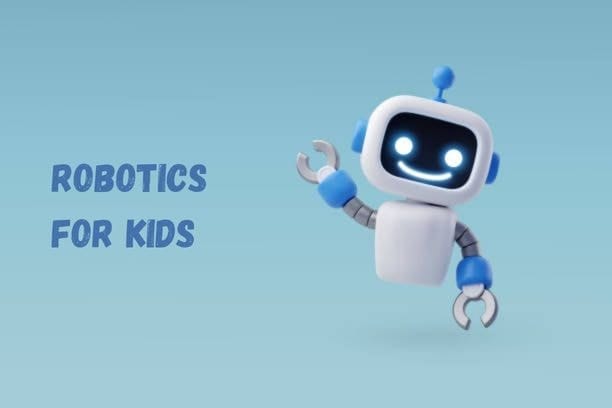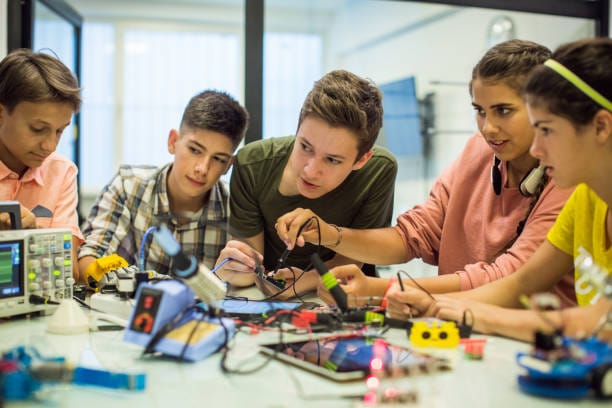Robotics for Kids: An Interesting Topic to Learn
Robotics for Kids: An Interesting Topic to Learn

The world around us is gradually turning into a technological world. Whether it is about automobiles, artificial intelligence, machine learning, or automated systems like self-driving cars, the role of technology is immense and expanding. One sub-category that seems to have received much attention and is a rapidly growing field in recent years is robotics for kids.
Robotics is an interesting and practical subject for children. It provides them with all the tools they will need for the future. Robotics is also useful in helping children build a robot from scratch or program it to perform a particular function.
In this blog, we will explore why robotics for kids is so intriguing and meaningful, why early engagement with it is worth it, and how the latest trends, like online robotic courses, help your kids better understand the robotics industry. Let’s dive in!
Young Robotics Engineers: Inspiring Success Stories
Around the world, talented robot enthusiasts from different age groups are pitching themselves up to become Robotics Engineers. They blend brilliance and innovation with creativity to tackle challenges within robotics. They fight environmental problems, create assistive technologies, and share gifted kids' challenging STEM achievements.
In this section, we are featuring some of the most motivated young Robotics enthusiasts who can be a good inspiration to young aspiring robotics engineers all over the world.

Ananya Chadha is a Toronto-based young girl who created projects including a brain-controlled prosthetic arm and AI. She has been applauded for her contribution to the interdisciplinary field of robotics and supports AI and Robotics for real-world problems.
Ben Stern—In his teens, he invented a robotic exoskeleton to help physically challenged individuals. His invention was awarded many prizes and attracted attention not only as a device that facilitates the lives of disabled people but also as a device that enhances their health.
Karishma Srivastava – When she was 12, Sanja invented an automatic system to identify toxic chemicals in the water using the robot. A school project that turned into invention: many prizes and showcasing the future of robotics in the environmental field.
Aaron Lin—Aaron Lin created an assistive robot for elderly people, primarily concerned with convenience. He then showcased his project at national robotics competitions and received commendations and recognition for his novelty in robotics and caregiving.
These examples demonstrate young, talented robotics engineers leveraging robotics to bring positive changes in health, mobility, and environmental solutions.
The Growing Importance of Robotics for Kids in Modern Education

Robotics has gradually been introduced into schools as society advances into the 21st century. The world is becoming interconnected, and new and equally strange technologies are implemented almost every day. In the same way, Robotics has been introduced, which helps children use the technologies early to enhance their ways of managing the modern-day world.
In schools, robotics should be incorporated to increase creativity, problem-solving abilities, computer science fundamentals, machine learning abilities, and mathematics. These are not only future career goals and skills in technology but also critical thinking and teamwork skills in all professions. Also, robotics for kids is not solely about assembling machines; it's more than that.
What Makes Robotics a Perfect Starting Point for Kids?

Robotics doesn’t sound all that complicated or tangy, so it's no wonder it’s easy for children to enter this field. Robotics for novices aims to teach children simple things and is good for children who have just begun familiarising themselves with technology.
Understanding of basic robotic systems that has to be explained to children

In its simplest form, robotics for kids is about recognizing the mechanisms and how one can get machines to perform a given activity using instructions. For beginners, the concepts are kept simple:
Motors and Sensors: Children begin with the basic facts that motors propel a robot's motion, but sensors enable it to interact with its surroundings.
Simple Coding: Through block-based coding equipment or popular programming languages like Scratch or Blockly, kids can instruct robots to move forward, turn, or stop. When they grow older, they can try more complicated assignments like building robots to perform given routes or the ability to solve mazes.
Building the Robot: Most new robots come with parts that the child can build himself or herself from scratch. This approach enables them to compound the relation between the robot's aspects and the activities it engages in.
Approachability of Beginner-Level Robotics

What makes robotics for beginners so appealing is its simplicity and interactivity. Beginner kits are designed to be intuitive and accessible for kids, even younger ones. Robotic toys and kits for young learners often include visual guides or step-by-step instructions that walk children through building and programming their robots. This approach lets them grasp basic concepts quickly and feel accomplished as they create their first functioning robot.
Key Benefits of Introducing Robotics for Kids at a Young Age

What makes robotics for beginners so attractive is that it is easy to work with and full of fun and challenge. Kids' starter kits are simple and easy to use and can be designed for kids even at a lower age. Many commercial toys and kits for young learners involve pictures or sequences of instructions that lead the students through building and programming their robots.
It helps them quickly understand some ideas and feel like they have accomplished something as they assemble their first robot. In the following section, we will look at some of the most important advantages of involving robotics in a kid's life.
Advantages of Teaching Robotics for Children at Their Early Ages

Playing with robotics for kids in early childhood has many benefits beyond understanding a robot's principles. Here are some of the key benefits:
Helps to foster the needed critical thinking and problem-solving skills.
If children are to participate in robotics, they must find ways to solve problems. Robotics teaches students how to debug a robot, how a robot works, or how to program a robot to run for a specific task, hence teaching the students problem-solving skills. These skills pertinent to comprehensiveness in life are invaluable.
Develop working relations within a team and analyze their ability to cope with hardships.
The majority of activities in robotics courses are best undertaken in groups. While creating robots individually, assembling them in pairs, discussing ideas, or finding a solution together teaches children teamwork and communication.
It also enhances the particular trait for working through trial and error: perseverance. When one strategy does not yield the desired result, a child learns to try the other repeatedly, and this resilience will help her/ him throughout his/her lifetime.
Stirs up Interest in the STEM Field
Get your children familiar with robots at an early age so they grow up appreciating and pursuing science or engineering careers. With robotics education, children can relate to the real-life use of mathematics, science, machine learning, and engineering. It often makes them develop a curiosity that could take them to computer science, engineering, or robotics-related fields.
An application of the transfer of learning across disciplines
Computer science and technical skills, such as logical thinking, creativity, and general technical knowledge that are acquired when handling robotics are applicable in almost all areas. Whether a person becomes a software engineer, an artist, or a businessperson, the problem-solving skills that are learned from robotics are applicable to every profession.
How Online Robotics Courses Make Learning Accessible and Fun

With technological advancements, many children worldwide have been enrolled in online robotics courses to learn about robotics and have opted to become robotics engineers in the last few years. These classes provide different benefits, making them a perfect choice for children who are seeking to start on robotics from the comfort of their own homes.
Flexibility and Convenience
The increase in the flexibility of the learning process is one of the major benefits of taking robotics courses online for learning robotics. It is easier for kids to learn directly from a teacher at their own convenience and at a learning rate that is convenient for them. Instead of enjoying their time after school or on weekends going to robotics class or sitting through class time-consuming hours, the children are freely able to set their schedules of when they will be attending the classes in their adopted online advanced courses model of learning without having to worry about wasting time commuting or even having to sit through class time-consuming hours.
Availability of a Rich Array of Information for young Robotics engineer
Web technologies provide several tools that may be useful in enhancing learning processes. This can be in the form of video demonstrations, exercises that one has to complete with the computer’s assistance, coding challenges, and or simulation exercises. These resources help in teaching so that every child can easily understand and grasp no matter how complex or simple the lesson is as compared to how it used to be in the past.
Blended Learning Environment of Computer Science and Robotics
In online classes, children can learn robotics at their rate of competence. Specific physical systems employ skill-level learning algorithms so children find the material easy yet engaging without it getting too complicated or tedious. This makes it easier to stay interested and to grasp what is being taught than when following the general pacing of a class.
Practical Experience and Participation
Even in many games that are conducted online, children are allowed to build and code robots to function in an online environment or in physical kits that are to be delivered to the home environment of the child. Everybody needs to practice this because after learning the theory, kids will be able to understand how it works in the real world and thus be capable of shining in various robotics careers.
Exciting Ways to Learn Robotics Engineering Through Fun Projects and Activities

Education does not have to be theoretical, especially when discussing matters such as robotics. Therefore there are several fun way where children can learn about robotics and mechanics, especially through enjoyable robotics projects and exercises. Here are a few examples:
Building Simple Robots: Many of the basic robotics kits involve simple constructs that children can put together and modify. After creating the robot, children can explore various actions and possibilities, such as line-following or a maze-solving robot.
Coding Challenges: Simultaneously, many platforms post coding quizzes where the children have to write basic scripts for programming robots. These obstacles may educate them on logical thinking and problem-solving while having fun, which is challenging and game-like.
Robotics Competitions: For more advanced learners, 'build your robots' competitions hosted across many cities are great opportunities to practice what they have learned while conducting research on consumer electronics and other technologies needed to build and own robots. This also motivates kids to improve their research skills and pursue careers as research scientists.
Such events are useful in that the children can pit their robots against others to compete and solve challenges that demand creativity, computer programming, and teamwork. Such competition helps kids gain professional certificates and enhance their online presence.
Practical robotics projects enable the students to practice what they have learned. If there is one reason why using hands-on projects to introduce children to robotics is effective, it is that the positive knowledge they gain is substantiated.
Whether these projects involve constructing a robot, writing a program, or solving a concern, they give students experiences and substantial use of theories and formulas, making learning more enjoyable for students.
Robotics Engineering for Kids as a Forecast into the Future of Technology

It could also be argued that robotics is the key player that will determine the future of this field. Robotics is on the cutting edge of many fields, and among the top of these are artificial intelligence, machine learning, automation, health & medicine, and space. With our robotics for kids; children are not learning a technique to address some of the current challenges, but instead preparing to become citizens of the future technology.

Exposing children early on to robotics enables them to appreciate how technology is developed and sets them up to be future employees in high-tech and machine learning-driven industries. In jobs as varied as designing robots for healthcare applications or working on new automated devices or artificial intelligence/machine learning, these children, who are learning robotics right now, will be the leaders of the future.
Conclusion

Going forward, it will be necessary to ensure that children find it easier to embrace robotics, machine learning, and other STEM subjects. Other social agents, such as schools, parents, and communities, also have the responsibility of fostering such interests by giving the children a chance to make a portfolio of their ideas.
Such remarkable young people can also be role models for other children to pursue success in robotics, machine learning, and other technology-related issues for future generations. Altogether, it is possible to share an interest in education and a passion for contributing to the improvements of the world.
Robotics for Kids - FAQs
What makes robotics for kids an essential skill in today’s digital world?

The advantages of having robotics classes remotely are that the presentation is computerized, it is easier to learn at your own pace, affordable and easily accessible, there is a wide variety of resources, and there are interactive hands-on exercises. Online classes are flexible and individualized to meet the needs of children who would love to learn robotics in their own way.
Why is robotics for beginners crucial for children's early education?

Robotics for beginners is important because it incorporates elements of difficulty and an initial understanding of the issue in question. These simple concepts assist children’s self-confidence and make a solid base for the subsequent robot building.
How can kids effectively learn robotics through CodeYoung's platforms?

CodeYoung covers structured live online classes for robotics learning solutions, with detailed tutorials and projects that help the children to think through and then act on the processes involved in robotics. CodeYoung realizes that children of all abilities should learn about robotics from qualified instructors and receive the necessary assistance as they proceed toward completing online robotics courses.
Why is robotics engineering for kids considered a significant skill as we live in the digital world?

In a contemporary society characterized by advanced technological features, knowledge of robotics enables children to handle problems that require strengths such as problem-solving, logical thinking, and knowledge of computer science. All these essential skills are necessary for robotics and also for deciphering the interaction of technology and machine learning that defines our tomorrow.
In what ways does it help make robotics classes easier for kids to learn?

Since robotics learning has no barriers and constraints, kids can opt to learn robotics at their convenience, use the resources available online, and even attend some virtual lessons if all the physical classes are closed. This makes the learning atmosphere comfortable and stimulating for the children as they learn robotics.